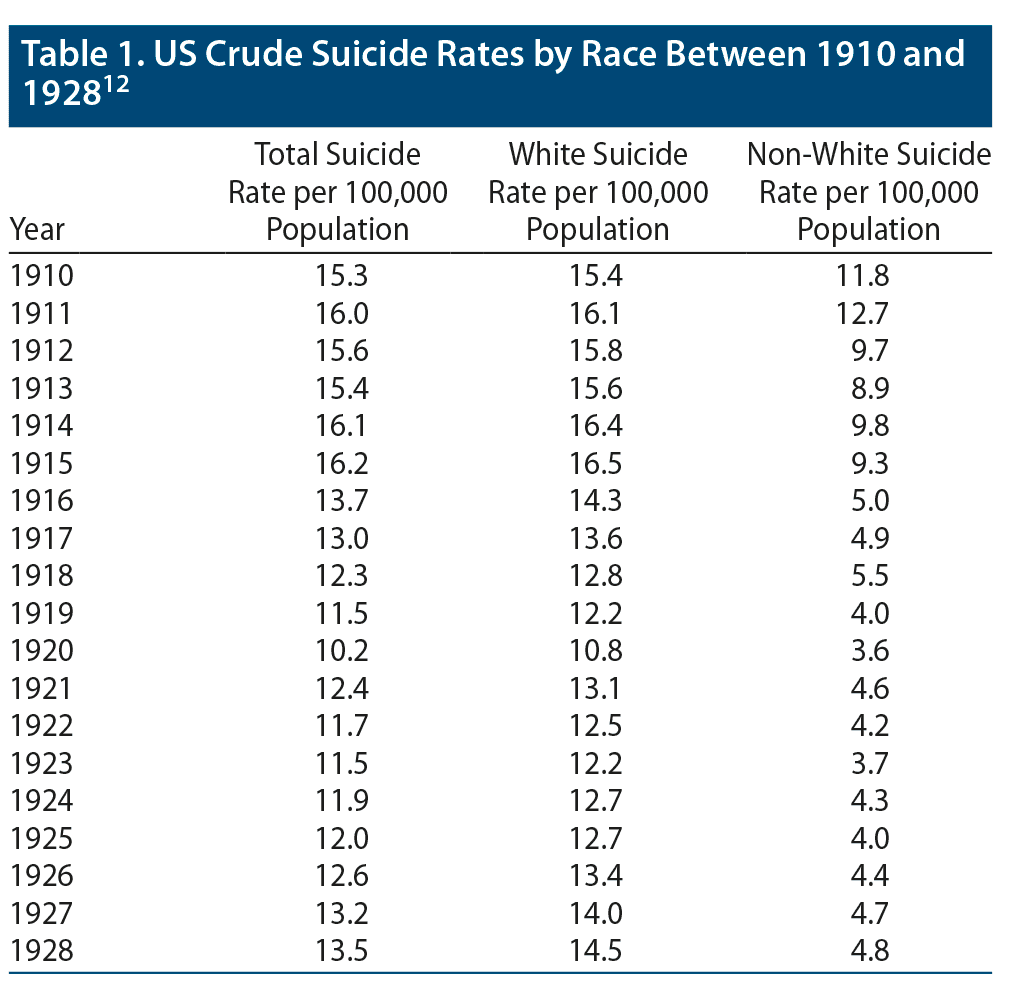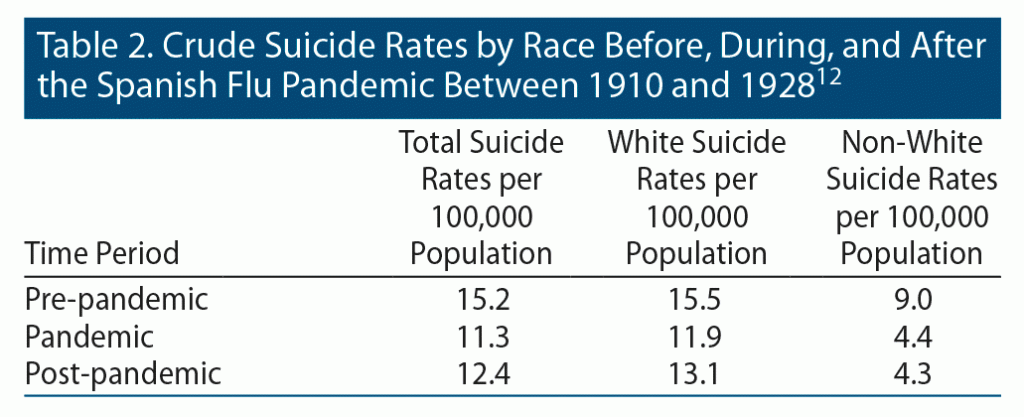
Prim Care Companion CNS Disord 2021;23(6):21com03088
To cite: Bastiampillai T, Allison S, Looi JCL. Spanish flu (1918–1920) impact on US suicide rates by race: potential future effects of the COVID-19 pandemic. Prim Care Companion CNS Disord. 2021;23(6):21com03088.
To share: https://doi.org/10.4088/PCC.21com03088
© Copyright 2021 Physicians Postgraduate Press, Inc.
aDepartment of Psychiatry, Monash University, Melbourne, VIC, Australia
bCollege of Medicine and Public Health, Flinders University, Adelaide, SA, Australia
cConsortium of Australian-Academic Psychiatrists for Independent Policy and Research Analysis (CAPIPRA), Canberra, ACT, Australia
dAcademic Unit of Psychiatry and Addiction Medicine, The Australian National University Medical School, Canberra Hospital, Canberra, ACT, Australia
*Corresponding author: Tarun Bastiampillai, BMedSc, MBBS, FRANZCP, Department of Psychiatry, Monash University, Wellington Rd, Clayton, Victoria 3800 ([email protected]).
Due to combined health and economic effects, the coronavirus disease 2019 (COVID-19) pandemic may increase US suicide rates.1 Previous epidemics may have increased suicide rates in some countries, such as Hong Kong (severe acute respiratory syndrome epidemic) and Taiwan (influenza pandemic: 1918–1920).2,3 However, Pirkis et al4 analyzed the early impact of the COVID-19 pandemic on global suicide rates, finding that suicide rates in 21 countries (16 high income and 5 upper-middle income) have either been stable or reduced. Within the United States, this study4 specifically found that California, Illinois, and Texas (4 counties) had reduced suicide rates, while Louisiana and New Jersey had stable suicide rates. The National Center for Health Statistics (NCHS) recently released provisional US mortality data for 2020, which estimated a 17.7% increase in overall mortality, but a 5.6% decline in US suicide rates compared to 2019 (reduced from 47,511 to 44,834 suicides).5 As context, Durkheim historically identified that major crises are often associated with a reduction in suicides, because great upheavals in society, like great popular wars, sharpen collective feelings, stimulate the party spirit and the national one and by concentrating activities towards a single end, achieve at least for a time, a greater integration of society.6(p208)
Despite these encouraging findings, there are early signs that the pandemic may disproportionately impact suicide rates among Black and other vulnerable populations in the United States, since they are more affected by the health and socioeconomic effects of COVID-19.7 There were significant racial differences in suicide mortality during the COVID-19 pandemic between Black and White populations in Maryland. Overall suicide mortality in Maryland declined by 16% between January 1 and July 7, 2020, compared to the equivalent 2017–2019 time frame, due to reduced suicide mortality for White residents by 24%, while Black residents experienced a 6% increase.7
To further understand the historic impact of pandemics on US suicide rates among the Black population, we have descriptively analyzed the effects of the Spanish flu pandemic by racial group as classified in the existing data. The Spanish flu pandemic killed 1%–2.7% of the world’s population and reduced US life expectancy by 13%, with 0.51% of the US population dying due to the disease.8,9 This analysis extends upon our previous research, which identified that overall US suicide rates actually reduced during the Spanish flu pandemic (1918–1920) compared with both the pre-pandemic (1909–1917) and post-pandemic periods (1921–1929).10 Despite experiencing much increased Spanish flu–related mortality11 and being more socioeconomically disadvantaged, declines in suicide rates were greater among the non-White (mostly Black) population than the White population (51% versus 23%) between 1918 and 1920 compared to the pre-pandemic period (1910–1917).12
US crude suicide rates reduced by 26% during the Spanish flu pandemic (1918–1920) compared to the pre-pandemic period (1910–1917) and increased by 10% in the post-pandemic period (1921–1928) compared to the pandemic period (Table 1 and Table 2).12 World War I occurred from 1914 to 1918, and the decline in US suicide rates from 1916 might have been related to greater social cohesion as the US prepared to enter the war (1917), with these low rates being extended by the social effects of the Spanish flu. Post-pandemic (1921–1928) US crude suicide rates increased for the White population by 10% and decreased by 2% for the non-White population (see Table 1 and Table 2).12
Despite their long history of significant social, political, and economic disadvantage related to discrimination and segregation, Blacks have consistently experienced less than half the suicide rate of the more advantaged White population since 1916.13,14 This discrepancy in suicide rates over the century since the Spanish flu has been described as the Black-White suicide paradox, because significant socioeconomic disadvantage and marginalization within a country usually predicts a higher suicide rate.13 Potential explanations for reduced Black suicide rates possibly relate to cultural protective factors, including a strong religious belief system, a collective social orientation, strong family and kinship bonds, communalism, affective expressiveness, present time orientation, and high levels of overall resilience.14 Durkheim would also have identified many of these sociocultural factors as protective of suicide, based on his theory of social integration being a crucial factor in reducing suicide rates.6 Durkheim found that Catholics had lower suicide rates compared with Protestants, which he hypothesized as being due to higher levels of social integration among Catholics.6 Perhaps when disasters occur such as the Spanish flu pandemic, Black communities with existing higher levels of social integration are more likely to “pull together,” resulting in increased suicide rate mitigation compared to relatively less socially integrated White populations. Furthermore, there may have been additional secular sociocultural changes in Black communities during the COVID-19 pandemic due to the concurrent Black Lives Matter movement.
However, it remains possible that Black suicide rates may have been consistently underestimated due to higher rates of misclassification.13 Non-White population suicide rates may have been undercounted, particularly during the period of the Spanish flu pandemic, but results within the same racial group reveal internally consistent trends in suicide rates.
Conclusion
The Spanish flu period is an important historical data reference point for understanding the impact of the COVID-19 pandemic on US suicide rates. Suicide rates declined in both the early phases of the COVID-19 pandemic and during the Spanish flu pandemic. Based on Durkheim’s sociological theory of suicide,6 the pulling-together effect during a crisis may have been observed in the Spanish flu–related reductions in overall US suicide mortality. These suicide rate reductions were more prominent in the Black population and were largely maintained during the century after the post-pandemic period. While the early findings in Maryland are concerning, the social cohesiveness of Black communities might provide some protection against the markedly higher suicide rates that would otherwise be expected during the COVID-19 pandemic due to disadvantage and high mortality rates. The relatively low and stable suicide rates among the Black population over the century after the Spanish flu further suggest that Black communities might be resilient in the face of a possible post–COVID-19 economic recession.
Given data quality concerns during the Spanish flu pandemic, these findings should be cautiously interpreted. Nevertheless, consistently low Black suicide rates and Black-White differences in suicide rates over the past century support the validity of the findings from the end of the pandemic.
While Black communities might be more socially resilient, contemporaneous research is required to analyze the ongoing impact of the COVID-19 pandemic on US suicide rates among vulnerable populations including by race/ethnicity, as disadvantaged groups are disproportionately affected by COVID-19–related health and economic impacts. Such research will help to guide effectively targeted policy decisions in relation to US suicide mitigation strategies. Research on social cohesion and welfare support measures is also needed to better understand their impacts on pandemic-induced suicide risk for vulnerable US communities.
Received: August 2, 2021.
Published online: November 18, 2021.
Potential conflicts of interest: None.
Funding/support: None.
References (14)

- Bastiampillai T, Allison S, Looi JCL, et al. The COVID-19 pandemic and epidemiologic insights from recession-related suicide mortality. Mol Psychiatry. 2020;25(12):3445–3447. PubMed CrossRef
- Cheung YT, Chau PH, Yip PS. A revisit on older adults suicides and Severe Acute Respiratory Syndrome (SARS) epidemic in Hong Kong. Int J Geriatr Psychiatry. 2008;23(12):1231–1238. PubMed CrossRef
- Chang Y-H, Chang S-S, Hsu C-Y, et al. Impact of pandemic on suicide: excess suicides in Taiwan during the 1918–1920 influenza pandemic. J Clin Psychiatry. 2020;81(6):20113454. PubMed CrossRef
- Pirkis J, John A, Shin S, et al. Suicide trends in the early months of the COVID-19 pandemic: an interrupted time-series analysis of preliminary data from 21 countries. Lancet Psychiatry. 2021;8(7):579–588. PubMed CrossRef
- Bray MJC, Daneshvari NO, Radhakrishnan I, et al. Racial differences in statewide suicide mortality trends in Maryland during the coronavirus disease 2019 (COVID-19) pandemic. JAMA Psychiatry. 2021;78(4):444–447. PubMed CrossRef
- Durkheim E. Suicide: A Study in Sociology. New York, NY: Free Press; 1897.
- Ahmad FB, Anderson RN. The leading causes of death in the US for 2020. JAMA. 2021;325(18):1829–1830. PubMed CrossRef
- Roser M. The Spanish flu (1918–1920): The global impact of the largest influenza pandemic in history. Our World in Data website. Accessed August 1, 2021. https://ourworldindata.org/spanish-flu-largest-influenza-pandemic-in-history
- Barro RJ, Ursúa JF, Weng J. The coronavirus and the great influenza pandemic: Lessons from the “Spanish flu” for the coronavirus’s potential effects on mortality and economic activity. Working Paper 26866. National Bureau of Economic Research website. Accessed August 1, 2021. https://www.nber.org/papers/w26866
- Bastiampillai T, Allison S, Brailey J, et al. Pandemics and social cohesion: 1918–1920 influenza pandemic and the reduction in US suicide rates. Prim Care Companion CNS Disord. 2021;23(3):20com02882. PubMed CrossRef
- Wade L. From Black Death to fatal flu, past pandemics show why people on the margins suffer most. Science website. Accessed August 1, 2021. https://www.sciencemag.org/news/2020/05/black-death-fatal-flu-past-pandemics-show-why-people-margins-suffer-most
- Long-term trends in deaths of despair. United States Congress Committee website. September 2019. Accessed August 1, 2021. https://www.jec.senate.gov/public/index.cfm/republicans/2019/9/long-term-trends-in-deaths-of-despair
- Rockett IR, Samora JB, Coben JH. The black-white suicide paradox: possible effects of misclassification. Soc Sci Med. 2006;63(8):2165–2175. PubMed CrossRef
- Utsey SO, Hook JN, Stanard P. A re-examination of cultural factors that mitigate risk and promote resilience in relation to African American suicide: a review of the literature and recommendations for future research. Death Stud. 2007;31(5):399–416. PubMed CrossRef
Enjoy free PDF downloads as part of your membership!
Save
Cite
Advertisement
GAM ID: sidebar-top






